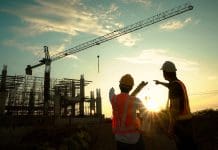Craig Smailes, project director at Kajima Partnerships, explores how modular construction can help to address the pressures on capacity and best practice across education following Covid-19
The UK Government has recently made significant spending pledges for public sector buildings — including a £1bn package of green investment to improve existing sites and a £1bn pledge towards 50 new school build programmes starting in 2021.
But whilst investing in improvements to existing buildings as part of post-pandemic recovery is of course welcome, I believe that Covid-19 is also an opportunity to think more innovatively about the future of school design and procurement.
In particular, if students are to return to school in-person, the need to increase classroom capacity so as to accommodate social distancing is crucial. But whilst often discussed in the context of housing, modular construction offers a viable, efficient, safe and cost-effective solution to this problem.
Solutions at pace
Pre-designed and pre-packaged, offsite manufacturing can deliver quality projects at speed and requires less time on site. Significantly accelerating delivery times, offsite manufacturing also mitigates the risk of unpredictable weather and environmental factors causing delays, while supply chain issues can be far more easily dealt with from the factory floor.
In the wake of the pandemic, such speed and efficiency is paramount. Estimates from the Construction Products Association suggest that construction site productivity declined by as much as 40% at the height of the pandemic, as lockdown made working onsite impossible for many developments. The good news is that anecdotal evidence suggests that productivity is recovering as contractors get to grips with new working practices, but onsite projects still cannot be delivered at the pace they once were.
Stalled procurement, frozen capital and delays in funding also have far-reaching implications for delivery times, with significant delays to existing school, hospital and public sector buildings. By contrast, the NHS Nightingale hospitals have been an example of just how quickly modular buildings can be delivered in order to flex up capacity in times of need.
Therefore, to prevent further delays and provide the additional capacity that schools need in the immediate term, modular construction is an obvious solution.
Prioritising safety
Taking place in a highly controlled and process-orientated environment where social distancing can be closely monitored, modular construction is also far less labour-intensive. Rather than moving between sites, workers are also typically employed at one location, making contact tracing amongst staff members far easier and providing a sense of certainty from a consistent location and regular community of colleagues.
With new Covid-19 health and safety practices remaining in place for the foreseeable future, the fact is that site closures and reduced teams on the ground will affect communities long after lockdown eases. But crucially, because offsite manufacturing can help to best prioritise worker safety and welfare, modular construction would prevent further delays to the new classrooms (not to mention diagnostic centres and hospital wards) that the UK urgently needs to address the impacts of the pandemic, even if only on a temporary basis.
Sustainability first
Public policy discussions are also increasingly focusing on a green economic recovery from the pandemic. The construction sector is no exception to this, with buildings and construction accounting for 40% of global carbon emissions. And for local authorities, schools and academy trusts looking to meet net-zero carbon goals by 2050, modular construction can play a valuable role.
In fact, factory building can reduce project waste by up to 90% and favours more sustainable materials, meaning that energy-efficient structures can be delivered with ease to meet national and local zero-carbon initiatives. Offsite manufacturing also significantly reduces traffic onsite, minimising noise and air pollution in the local area, which, for students especially, can be profoundly distracting.
Re-use is also critical to enhancing sustainability. Rapidly deployed onsite, modular classrooms can either help schools to navigate immediate pressures on classroom capacity, or be a temporary solution during longer renovation and building projects and then later redeployed elsewhere.
Driving best practice
Modular buildings can also play a key part in helping schools achieve best practice, both in the wake of the pandemic and for the long term. Far from the stereotypical post-war prefab homes, modular construction can now deliver best-in-class facilities, including greater energy efficiencies, as well as incorporating accessibility requirements.
And as schools look to facilitate a full return of students to in-person teaching, managing the pressures of social distancing on capacity is a must. Modular classrooms therefore provide a solution to the challenge of many schools currently not having enough classroom space to accommodate all students on site.
But the benefits of modular go beyond simply allowing social distancing in the immediate term. For instance, modular construction can be used to deliver new facilities at pace over summer holidays, or provide temporary space during longer term construction projects that cannot be completed over just one school break. This can significantly minimise disruption for students by providing a high quality setting where learning can be prioritised.
For cash-strapped schools, financing projects is also crucial. Even on a temporary basis, committing to construction projects can be time and cost-intensive. However, leasehold financing options are making modular structures viable and attractive, as both temporary and permanent solutions. Meanwhile the ability to redeploy structures, shorter timelines and more efficient delivery mean that costs can be readily managed and Return on Investment objectives met.
Where next?
Immediate solutions are needed for schools navigating the challenges of Covid-19 and social distancing as they prepare to reopen. Modular construction presents a clear and viable answer for addressing these pressures.
But we must also look to the future, as schools strive to deliver a quality education for students that have been significantly impacted by the disruption of the pandemic.
Government investment in school refurbishment, energy efficiency and new construction projects is important, but only by turning to innovative solutions like offsite manufacturing can we deliver best-in-class facilities with sustainability, affordability and safety at their heart.
Craig Smailes
Project director
Twitter: @KajimaEurope
LinkedIm: Kajima Properties (Europe) Limited













